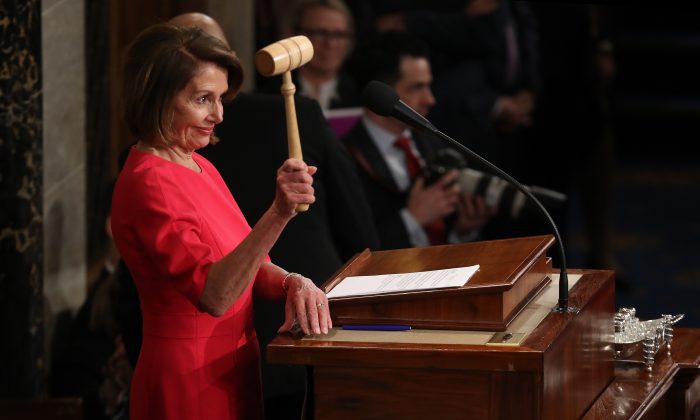By Joseph Lord
After a Tuesday meeting of the Democratic caucus, Speaker of the House Nancy Pelosi (D-Calif.) spent much of the press conference discussing the debt ceiling. As Republicans continue to block Democratic efforts to raise the debt limit, Pelosi indicated that members of her caucus are already looking for ways to avoid the challenge in the future—specifically, by giving the president-appointed secretary of the Treasury the power to raise the debt limit on their own.
The caucus meeting came after the Senate rejected debate on the Democrat-authored continuing resolution to fund the government Monday evening in a roughly party-line vote. The vote was the culmination of months of posturing by Senate Republicans, who have insisted since August that they would not vote to increase the debt limit.
In a petition drafted by Sen. Ron Johnson (R-Wis.), 46 Republicans signatories—including former presidential candidates Sens. Mitt Romney (R-Utah), Lindsey Graham (R-S.C.), and Rand Paul (R-Ky.), and Senate Minority Leader Mitch McConnell (R-Ky.)—explained their reasoning.
The petition accused Democrats of an “unprecedented deficit spending spree,” and insisted that they should take ownership for the spending by raising the debt limit on their own. While Democrats do have the votes to do this, it has been an avenue that Democratic leaders have been unwilling to take, as some polls have shown that debt ceiling increases are unpopular with the American people (pdf).
Pelosi, Democrats Considering Both Legislative and Executive Options After Senate Vote
In her Tuesday press conference, Pelosi discussed Democratic plans in the wake of this vote. Because of the “imminent” nature of the debt ceiling crisis, Pelosi said that the caucus spent most of their time on the debt ceiling issue.
She warned of the effects from failing to raise the debt ceiling, including a default for the first time in American history. Such a default, Pelosi said, would wipe out “trillions in family wealth” for middle Americans. Pelosi also warned that “Just the discussion of … failing to raise the debt ceiling [under the Obama Administration] lowered our credit rating.”
She continued: “This is not about future spending, this is to pay the bills that were incurred. Only 3 percent of this is about Joe Biden’s presidency. The bulk of it is under the previous president’s administration.”
Still, Pelosi said that Democrats plan to put forward a new “clean” continuing resolution, the only effect of which would be to continue to fund the government through December. The continuing resolution rejected Monday by the Senate was significantly more expansive, ordering billions in new spending to address the ongoing Afghan special immigrant crisis and the aftereffects of Hurricane Ida.
On the Senate floor Monday, McConnell indicated that he and other Republicans may be willing to vote for such a resolution.
Pelosi also discussed much more ambitious executive options for resolving the current crisis and preventing such crises in the future.
Pelosi criticized the opposition party for their vote.
“When the Republicans refuse to cooperate on this, they are jeopardizing the full faith and credit of the United States of America, which is guaranteed in the Constitution,” she said.
Here, Pelosi is referencing the so-called “public debt clause” of the 14th amendment, which reads, “The validity of the public debt of the United States, authorized by law, including debts incurred for payment of pensions and bounties for services in suppressing insurrection or rebellion, shall not be questioned.” Though the clause was a post-Civil War amendment meant to deal with immediate issues at the time, some have interpreted the clause as giving the president unilateral authority to raise the debt ceiling.
President Bill Clinton, discussing a similar standoff over the debt ceiling in the mid-90s, interpreted this cause to give the president authority to raise the debt limit on his own authority if Congress fails to do so. Clinton said he would have used the clause “without hesitation, and force the courts to stop me.” But many, including President Barack Obama, have been unconvinced of the constitutionality of this move.
Though it is unclear how such an executive action would work, Pelosi indicated that Democrats were considering it.
“I’ll let you know soon,” she replied when asked if the clause would be used. “The point is it’s in the Constitution. We really do not have to go through this all the time.”
Pelosi also said that Democrats were considering options to give the Treasury Secretary the power to raise the debt limit, a suggestion that she said was put forward by Reps. Brendan Boyle (D-Pa.) and John Yarmuth (D-Ky.). Yarmuth has previously suggested that Congress’s role in the debt ceiling should be abolished altogether.
Read More From The PatriotAmerican
The House Speaker clarified how this new process would work. Because of constitutional requirements that debt and revenue schemes be approved by Congress, Pelosi said that Congress would have the power to reject a debt limit increase undertaken by the Treasury Secretary after the fact. But that would require at a minimum 51 senators as well as a signature from the president, a move that would severely constrict the minority party’s ability to stop or reject such raises.
“Nevertheless,” said Pelosi, “it has to be addressed and it’s about paying past bills.”


There is a reason the House has control of the purse. As much as the Dems want to give this power to the President they can’t. We the people send our Rep’s to congress to do our bidding. We want them to represent us the people. They will vote for or against raising the debt but if they don’t then they will need to work it out. Or shut it down. I for one would let the government shut down until they figure a way to cut spending.